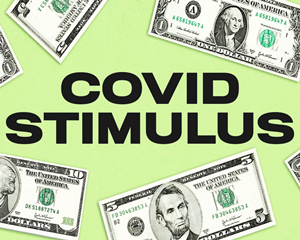In March 2020, the COVID-19 pandemic rocked economies worldwide.
在2020年3月,新冠疫情震荡了世界经济。
Millions of people lost their jobs, and many businesses struggled to survive or shut down completely.
数百万人失业,而许多企业挣扎求生或完全倒闭。
Governments responded with some of the largest economic relief packages in history -- the United States alone spent $2.2 trillion on a first round of relief.
政府们通过一些历史上最大的经济救助项目--单是美国就在其首次救助中花费了22亿美金。
So where did all this money come from?
那么这些钱都是从哪来的?
Most countries have a central bank that manages the money supply and is independent from the government to prevent political interference.
大多数国家有一家中央银行来管理货币储备,并且独立于政府来防止政治干预。
The government can implement many types of economic policy,
政府可以施行多种经济政策,
like decreasing people's taxes and creating jobs through public infrastructure projects, but it actually can't just increase the money supply.
比如减少税收和通过公共基建项目创造工作机会,但是政府并不能直接地增加货币储备。
The central bank determines how much money is in circulation at a time.
中央银行决定有多少资金在流通。
So why can't central banks authorize the printing of unlimited money to help an economy in crisis?
那么为什么中央银行不能授权印无限数量的钞票帮助危机中的经济呢?
They could, but that's a short-term solution that doesn't necessarily boost economic growth in the long-term, and can actually hurt the economy. Why?
它们可以,但是这是一种短期手段,它在长期并不真正帮助经济增长,而且还可能损害经济。为什么?
With more money in circulation, manufacturers of goods like food, clothing, and cars could respond to demand simply by raising prices,
流通的钱越多,例如食品、衣物和汽车制造商能够简单地针对需求抬高价格,
rather than manufacturing more of these goods and creating new jobs in the process.
而不是制造更多产品并同时创造新工作。
This would mean you could no longer buy as much with the same amount of money -- a situation known as inflation.
这意味着你再也不能用同样多的钱买同样多的东西--这个状况叫做通货膨胀。
A little bit of inflation, about 2% a year, is considered a sign of economic health, but more can quickly derail an economy.
一点点通货膨胀,大该一年百分之二,被认为是经济健康的表现,但更多可以快速导致经济脱轨。
In recent decades, central banks have tried an approach called quantitative easing to infuse the economy with cash while maintaining a low risk of severe inflation.
在最近几十年,中央银行尝试过一种叫做量化宽松的方式来为经济注入资金同时保持较低的严重通货膨胀风险。
In this approach, a central bank increases cash flow by purchasing another entity's bonds.
在这个方法中,一间央行通过购买另一机构的债券来增加基金流动。
Anyone can buy bonds from corporations or governments.
任何人都能从公司或政府那里购买债券。
When you buy a bond, you're essentially loaning money to the company -- or government -- with the promise that they'll pay it back later with interest.
在你购买债券时,你实际上是把钱借给公司--或政府--接受它们会在之后把本金和利息一起归还的承诺。
This is why buying bonds is sometimes referred to as buying debt.
这是为什么购买债券有时被称作是购买债务。

When an individual buys a bond, they're using money that's already in circulation.
当一个个体购买一份债券,他们用的是已经在流通中的钱。
But when the central bank buys a bond, it essentially creates cash, supplying money that didn't exist before in exchange for bonds.
但是当央行购买一份债券,它本质上是在造钱,提供出之前不存在的资金来换成债券。
Both during the 2008-2009 financial crisis and again in 2020,
在2008-2009年金融危机以及2020年又一次金融危机期间,
the United States' central bank, the Federal Reserve, bought bonds from the US government called treasury bonds.
美国的中央银行,也就是美联储,向美国政府购买叫做长期国债的债券。
Historically, many people have purchased these bonds as a safe form of investment, knowing the US government will pay them back with interest.
历史上来说,很多人购买国债来作为一种安全的投资,因为美国政府会连本带利一起付还。
In early 2020, the Federal Reserve pledged to buy unlimited treasury bonds, loaning the U.S. government an unprecedented amount of money
在2020年早期,美联储保证购买不限量的长期国债,借给美国政府空前大量的资金,
cash that the government used to fund relief efforts like stimulus checks and unemployment benefits.
给政府用来为救济募资,比如经济刺激补助和失业补贴。
This isn't equivalent to simply printing money, though it may sound similar.
这和简单地印钱并不相同,即使它听起来相似。
Because of the way bonds are priced, by buying so many, the Federal Reserve effectively lowered the return on them,
由于债券被定价的方式,通过购买很多,美联储有效地降低了它们的回利,
which incentivizes other investors to lend to riskier entities -- like small and midsize companies -- in order to get a decent return.
这促使其他投资者向更有风险的选择放贷--比如中小企业--以获得可观的回报。
Encouraging lending this way should help companies of all sizes borrow money to funnel into projects and hires,
通过鼓励这种借贷方式,应该能帮助大小公司借款来投入到项目和雇佣,
boosting the economy over time in addition to helping the government supply people with urgently needed cash in the short term.
从长期促进经济并帮助政府为有紧急需求的人们在短期提供资金。
The Federal Reserve's pledge to buy unlimited government debt has raised some questions -- and eyebrows.
美联储对购买不限量长期国债的保证引发一些问题和怀疑。
In theory, this means the government could issue more bonds, which the central bank would purchase.
理论上,这意味着政府可以发放更多债券,央行会购买这些债券。
The government could then use the money from the new bonds to pay off the old bonds, effectively meaning the government never pays back its debt to the central bank.
政府之后可以用新债券得到的钱来还清以前的债券,这意味着政府永远不会归还欠央行的钱。
Citing this and other theoretical scenarios, some economists have raised concerns that a central bank buying government debt is a subversion of a system designed to protect the economy.
引用这个和其它理论上的情景,一些经济学家担心央行购买国债是对经济保护系统的颠覆。
Others have insisted these measures are necessary, and have so far helped stabilize economies.
其他人则坚持这些手段是必要的,认为至目前为止已经帮助稳定了经济。
Though quantitative easing has become a lot more common in recent years, it's still relatively new, and potential consequences are still unfolding.
虽然量化宽松在近年已变得更加普遍,它依旧相对较新,且可能产生的后果还有待观察。












